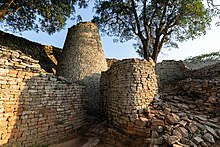Magna Zimbabua


Magna Zimbabua, olim Simbaoe et Symbaoe, est urbs mediaevalis in australibus et orientalibus Zimbabuae collibus prope Mutirikwe lacum et Masvingo oppidum. Fuisse putatur certi regni magni caput (sed qualis regni incertum est[1]) tempore civitatis Aetate Ferrea exeunte vigentis. Urbs saeculo nono aedificari coepit, sed saeculo quinto decimo relicta est.[2][3] Aedificia exstantia a maioribus gentis Sonarum erecta esse putantur.[4] Urbs lapidea aream 7.22 chiliometrorum quadratorum comprehendit, quae usque ad 18 000 hominum continere poterat, ut crebritas civium 2500 fere per chiliometrum quadratum esset. Agnoscitur patrimonium totius mundi ab UNESCO.
Magna Zimbabua fuisse caput Monomotapae et regium monarchae loci palatium ab archaeologis censetur, itaque sedes potestatis civilis. Inter praestantes aedificii proprietates erant moenia, quorum nonnulla erant undecim metra alta,[5] sine arenato (ratione lapide sicco) exstructa. Urbs ad ultimum relicta et obsolefacta est.
Prima Magna Zimbabuae mentio in litteris ex anno 1531 legitur in scripta Vincentii Pegado, ducis Sofalae, castri Portugallici in litore Mozambici hodierni siti, qui urbem Symbaoe appellavit. Europaei autem locum saeculo undevicensimo exeunte primum viserunt, quem investigare serio coeperunt anno 1871.[6]
Pinacotheca[recensere | fontem recensere]
-
Despectus in Magnam Zimbabuam. Magnus locus moenibus munitus est magnum saeptum, ante quem aliquot reliqua videri possunt.
-
Despectus in regionem australem et orientalem..
-
Conspectus ad occidentem ex saepto orientali..
-
Exemplar Avis Zimbabuensis.
-
Magna Zimbabua legitur, nomine Simbaoe, in Africae Tabula Nova, tabula Abrahami Ortelii anno 1570 edita.
-
Turris conica.
-
Magnum saeptum.
-
Magnum saeptum.
-
Magnum saeptum.
-
Multiplex clivosus ex valle visus.
-
Superum limen in ostia.
Nexus interni
Notae[recensere | fontem recensere]
- ↑ "Great Zimbabwe in Historical Archaeology."
- ↑ Beach 1998.
- ↑ Department of the Arts of Africa, Oceania, and the Americas 2001.
- ↑ "Great Zimbabwe: African City of Stone". 10 Martii 2017.
- ↑ Owen Jarus, "Great Zimbabwe: African City of Stone," LiveScience, 9 Martii 2017.
- ↑ Fleminger, David (2008). Mapungubwe Cultural Landscape. 30 Degrees South. p. 57. ISBN 978-0-9584891-5-7
Bibliographia[recensere | fontem recensere]
- Beach, David. 1998. "Cognitive Archaeology and Imaginary History at Great Zimbabwe." Current Anthropology 39: 47–72. doi:10.1086/204698. S2CID 143970768.
- Beach, David N. 1980. The Shona and Zimbabwe 900–1850. Londinii: Heinemann; Gwelo: Mambo Press. ISBN 0-435-94505-X.
- Bent, James Theodore. 1892. The Ruined Cities of Mashonaland. Londinii: Longmans & Green.
- Böhmer-Bauer, Kunigunde. 2000. Great Zimbabwe: Eine ethnologische Untersuchung. Studien zur Kulturkunde, 115. Coloniae. ISBN 3-89645-210-X.
- Bruwer, Andries Johannes. 1965. Zimbabwe: Rhodesia’s Ancient Greatness. Johannesburg. 1945: Hugh Keartland.
- Chirikure, Shadreck, et Innocent Pikirayi. 2008. "Inside and outside the dry stone walls: revisiting the material culture of Great Zimbabwe." Antiquity 82: 976–93. PDF.
- Chirikure, Shadreck, Thomas Moultrie, Foreman Bandama, Collett Dandara, et Munyaradzi Manyanga. 2017. "What was the population of Great Zimbabwe (CE1000 – 1800)?" PLoS ONE, 6 Decembris, 2017. e0178335. doi:10.1371/journal.pone.0178335.
- Connah, Graham. 1987. African Civilizations: Precolonial Cities and States in Tropical Africa. Cantabrigiae.
- Department of the Arts of Africa, Oceania, and the Americas. 2001. "Great Zimbabwe (11th–15th century)." Heilbrunn Timeline of Art History, October 2001. Novi Eboraci: The Metropolitan Museum of Art. Verba interretialia.
- Fontein, Joost. 2006. The Silence of Great Zimbabwe: Contested Landscapes and the Power of Heritage. Novi Eboraci: UCL Press. ISBN 1-84472-122-1.
- Fontein, Joost. 2006. "Silence, Destruction and Closure at Great Zimbabwe: local narratives of desecration and alienation." Journal of Southern African Studies 32 (4): 771–94. doi:10.1080/03057070600995723.
- Garlake, Peter S. 1973. Great Zimbabwe: New Aspects of Archaeology. Londinii: Thames & Hudson. ISBN 978-0-8128-1599-3.
- Garlake, Peter S. 1975. Simbabwe: Goldland der Bibel oder Symbol afrikanischer Freiheit? Bergisch Gladbach. ISBN 3-7857-0167-5.
- Garlake, Peter S. 1982. Great Zimbabwe. Urbe Hararensi: Zimbabwe Publishing House. ISBN 978-0-949932-18-1.
- Garlake, Peter S. 1984. "Ken Mufuka and Great Zimbabwe." Antiquity 58: 121–23.
- Garlake, Peter S. 1987. Structure and Meaning in the Prehistoric Art of Zimbabwe. Blumingtoniae. ISBN 0-941934-51-9. PDF.
- Garlake, Peter S. 2002. Early Art and Architecture of Africa. Oxoniae: Oxford University Press. ISBN 0-19-284261-7. Verba interretialia.
- Hertelm, Peter. 2000. Zu den Ruinen von Simbabwe. Gothae: Perthes. ISBN 3-623-00356-5.
- Huffmann, Thomas N. 1996. Snakes and Crocodiles. Power and Symbolism in Ancient Zimbabwe. Johannesburg: Witwatersrand University Press. ISBN 1-86814-254-X.
- Humme, Siegbert. 1999. Simbabwe: das noch ungelöste archäologische Rätsel des afrikanischen Kontinents; neue ethnologische, kulturgeschichtliche und linguistische Vermutungen. Ulm. ISBN 3-931997-10-3.
- Kuklick, Henrika. 1991. "Contested monuments: the politics of archaeology in southern Africa." In Colonial situations: essays on the contextualization of ethnographic knowledge, ed. George W. Stocking, 135–170. University of Wisconsin Press. ISBN 978-0-299-13124-1.
- Matenga, Edward. 1993. Archaeological Figurines from Zimbabwe. Societas Archaeologica Upsaliensis, Uppsalae. PDF.
- Matenga, Edward. 1998. The Soapstone Birds of Great Zimbabwe: Symbols of a Nation. Urbe Hararensi. ISBN 1-77901-135-0.
- Matenga, Edward. 2008. Soapstone Birds of Great Zimbabwe: Symbols of a Nation. Urbe Hararensi: African Publishing Group. ISBN 978-1-77901-135-0.
- Mufuka, K. Nyamayaro, K. Muzvidzwa, et J. Nemerai. 1983. Dzimbahwe: Life and Politics in the Golden Age, 1100–1500 A.D. Urbe Hararensi: Harare Publishing House.
- Pikirayi, Innocent. 2001. The Zimbabwe culture: origins and decline of southern Zambezian states. Rowman Altamira. ISBN 978-0-7591-0091-6.
- Pleticha, Heinrich, ed. 1985. Simbabwe: Entdeckungsreisen in die Vergangenheit. Stutgardiae. ISBN 3-522-60620-5.
- Shillington Kevin. 2005. History of Africa. Ed. secunda. Oxoniae: Macmillan Education. ISBN 0-333-59957-8.
- Sommerlatte, Herbert W. A. 1987. Sommerlatte: Gold und Ruinen in Zimbabwe: Aus Tagebüchern und Briefen des Schwaben Karl Mauch (1837–1875). Gütersloh. ISBN 3-570-07918-6.
- Vogel, Joseph O. 1994. Great Zimbabwe. The Iron Age in South Central Africa. Novi Eboraci: Garland Publishing. 1994, ISBN 0-8153-0398-X.
- Summers, Roger. 1970. "The Rhodesian Iron Age.". In Papers in African Prehistory, ed. J. D. Fage et Roland Oliver. Cantabigiae: Cambridge University Press. ISBN 978-0-521-09566-2. Verba interretialia.
- Ucko, Peter J. 1995. Theory in Archaeology: A World Perspective. Routledge. ISBN 978-0-203-97328-8.
Nexus externi[recensere | fontem recensere]
| Vicimedia Communia plura habent quae ad Magnam Zimbabuam spectant. |
20°16′S 30°56′E / 20.267°S 30.933°E
- "Great Zimbabwe." UNESCO World Heritage.












